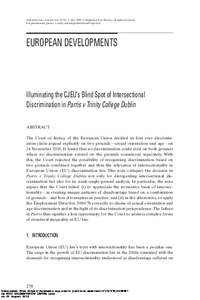Illuminating the CJEU's blind spot of intersectional discrimination in Parris v Trinity College Dublin

2018
47
2
July
278-296
labour law ; EU Court of Justice ; age discrimination ; sexual orientation ; EU law ; case law
Law
http://dx.doi.org/10.1093/indlaw/dwy007
English
"The Court of Justice of the European Union decided its first ever discrimination claim argued explicitly on two grounds—sexual orientation and age—on 24 November 2016. It found that no discrimination could exist on both grounds where no discrimination existed on the grounds considered separately. With this, the Court rejected the possibility of recognising discrimination based on two grounds combined together and thus the relevance of intersectionality in European Union (EU) discrimination law. This note critiques the decision in Parris v Trinity College Dublin not only for disregarding intersectional discrimination but also for its weak single-ground analysis. In particular, the note argues that the Court failed: (i) to appreciate the normative basis of intersectionality—as creating unique patterns of disadvantage based on a combination of grounds—and how it transpires in practice; and (ii) in the alternative, to apply the Employment Directive 2000/78 correctly to claims of sexual orientation and age discrimination and in the light of its discrimination jurisprudence. The failure in Parris thus signifies a lost opportunity for the Court to address complex forms of structural inequality in EU law. "
Digital
The ETUI is co-funded by the European Union. Views and opinions expressed are however those of the author(s) only and do not necessarily reflect those of the European Union or the ETUI.